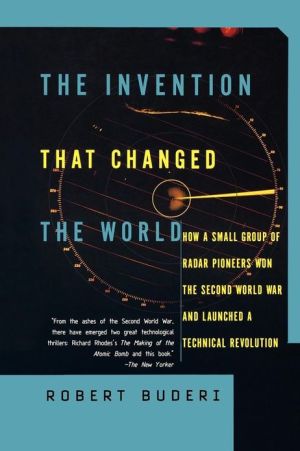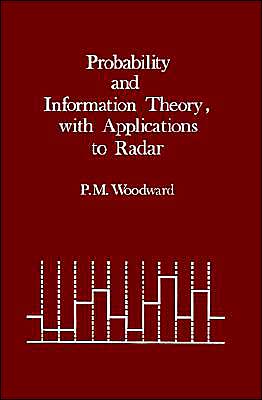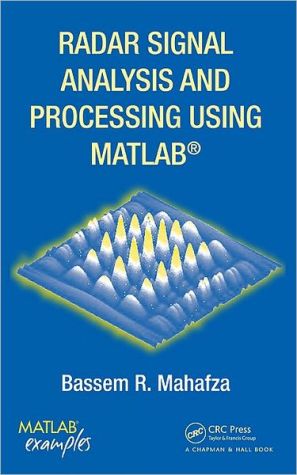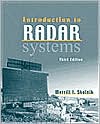The Invention That Changed the World: How a Small Group of Radar Pioneers Won the Second World War and Launched a Technological Revolution
The Invention That Changed the World is the great and largely untold story of the colorful band of brilliant scientists who created the microwave radar systems that not only helped win World War II but set off a veritable explosion of scientific achievements and technological advances that have transformed our daily lives. The story begins in September 1940 with the arrival in Washington of a team of British scientists bearing England's most closely guarded technological secrets, among them...
Search in google:
The Invention That Changed the World is the great and largely untold story of the colorful band of brilliant scientists who created the microwave radar systems that not only helped win World War II but set off a veritable explosion of scientific achievements and technological advances that have transformed our daily lives. The story begins in September 1940 with the arrival in Washington of a team of British scientists bearing England's most closely guarded technological secrets, among them the cavity magnetron, a revolutionary new source of microwave energy that was to pave the way for radar systems small enough to fit on planes and ships. The magnetron's arrival triggered the most dramatic mobilization of science in history as America's top scientists enlisted in the "war within the war" to convert the British invention into a potent military weapon. Developed in a top-secret rush at the Radiation Lab on the campus of MIT, microwave radars eventually helped destroy Japanese warships in the Pacific, brought down Nazi buzz bombs over England, and enabled Allied bombers to "see" through cloud cover over Germany and Japan. Although the atomic bomb ended World War II, in many ways radar won it. Capturing all the drama and excitement of the race to develop radar, The Invention That Changed the World then follows the postwar careers of the radar scientists as they applied the knowledge gained from their wartime work in many different fields. The Rad Lab was an incubator for science and technology on a scale perhaps unprecedented in history. Among their many achievements, radar veterans were instrumental in creating the field of radio astronomy and discovering nuclear magnetic resonance, the transistor, and the maser, breakthroughs that led to the Nobel Prizes. In the continuing push to develop early warning systems during the Cold War, other radar men helped create the basis for digital computer memories. In very practical ways, radar and its spin-offs continue to e Publishers Weekly As the former technology editor for Business Week, Buderi understands his complex subject well enough to render it clear without oversimplifying it. The first half of his book makes a strong case that the atomic bomb only ended WWIIit was radar that won it. Radar tipped the balance in the Battle of Britain, at Midway and in the Solomons. Radar haunted the U-boats and helped control the V-1 attacks of 1944-45. Meanwhile, radar countermeasures and navigation systems set the stage for the D-Day landings. Buderi tells this story well, with an unusual ability to describe technical subjects in language a nonspecialist can comprehend. In the second half of the book, he devotes half a dozen chapters to biographical sketches of key, albeit little-known, participants in the wartime radar program. Finally, the author brings to center stage radar technology's contributions to the Cold War and to space astronomy. While this concluding discussion is informative, it scants other areas influenced by radar. Subjects such as air-traffic control and weather reporting deserve better than relegation to an epilogue. Overall, this is a vigorous history, but an unfocused one. Photos, not seen by PW. (Oct.)
\ Publishers Weekly\ - Publisher's Weekly\ As the former technology editor for Business Week, Buderi understands his complex subject well enough to render it clear without oversimplifying it. The first half of his book makes a strong case that the atomic bomb only ended WWIIit was radar that won it. Radar tipped the balance in the Battle of Britain, at Midway and in the Solomons. Radar haunted the U-boats and helped control the V-1 attacks of 1944-45. Meanwhile, radar countermeasures and navigation systems set the stage for the D-Day landings. Buderi tells this story well, with an unusual ability to describe technical subjects in language a nonspecialist can comprehend. In the second half of the book, he devotes half a dozen chapters to biographical sketches of key, albeit little-known, participants in the wartime radar program. Finally, the author brings to center stage radar technology's contributions to the Cold War and to space astronomy. While this concluding discussion is informative, it scants other areas influenced by radar. Subjects such as air-traffic control and weather reporting deserve better than relegation to an epilogue. Overall, this is a vigorous history, but an unfocused one. Photos, not seen by PW. (Oct.)\ \ \ \ \ Library JournalMuch of our view of the technological achievements emerging from World War II is driven by nuclear fetishism, but a more fundamental truth is revealed in the subtitle to this remarkable book. Buderi, former technology editor for Business Week, traces the radiation revolution from its earliest beginnings to today. This captivating tale of a dedicated group of scientists and engineers begins with a small box carrying all of Britain's wartime secrets on its mythiclike journey to MIT. Gizmos, glitches, and gadgets that eventually won the war for the Allies are then introduced. That's only half the story: Buderi then pursues the unlikely heroes and their creative energies into postwar inventiveness. Through extensive interviews and impressive bibliographies, the author has produced a fascinating history. If the rest of the "Sloan Technology" series is like this, interested readers will want to read them all.John J. Yurechko, Georgetown Univ., Washington, D.C.\ \ \ Matthew L. WaldA torrent of modern technology runs through [this] impressive overview. -- Matthew L. Wald, The New York Times Book Review\ \ \ \ \ Kirkus ReviewsIn a narrative that often reads as compellingly as the best spy fiction, freelance science writer Buderi tells the story of how British and American scientists developed microwave radar, a device that helped win WW II and spurred a transformative postwar technical revolution.\ In Liverpool in August 1940, at the height of the Battle of Britain, British scientists secretly accompanied a mysterious black box aboard a Canadian liner bound for the US. Inside was one of Britain's most closely guarded military secrets: a cavity magnetron, a radar transmitter that made the precise identification of military targets possible—even at night and during inclement weather. Brushing aside American prewar isolationism, American and British scientists, working under the aegis of American government and industry, formed the Radiation Lab at the Massachusetts Institute of Technology for exploring scientific applications for Britain's microwave research. Buderi tells the riveting story of the "wizard war," as Allied and German scientists attempted to trump each other in horrific technological gadgetry and electronic measures and countermeasures. The ultimate triumph of the Anglo- American scientists was a key to Allied victory in the air and U-boat wars. Aided by excellent British intelligence, including now-famous intercepts of the German Enigma encoding machine, British scientists were able to disrupt radar guiding German bombers over England, prevent German electronic devices from detecting British planes over Europe, and jammed German broadcasting. American refinement of a British radar invention resulted in the disruption, and ultimately the cessation, of German V-1 rocket attacks on London. After the war, Buderi points out, the work of the microwave radar pioneers resulted in a potpourri of technical advances in engineering that transformed American life, including transistors, microwave ovens, and computers, and in advances in astronomy, including radiotelescopes.\ A fascinating story, well told.\ \ \







